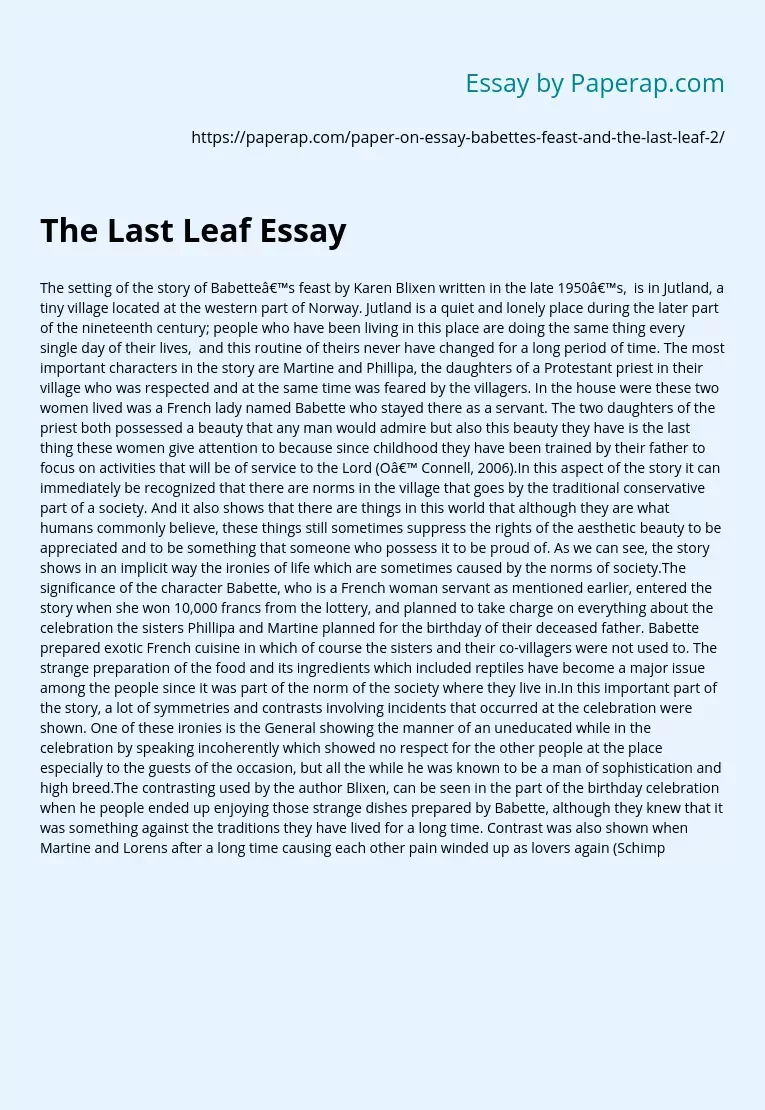The Last Leaf Essay
The setting of the story of Babette’s feast by Karen Blixen written in the late 1950’s, is in Jutland, a tiny village located at the western part of Norway. Jutland is a quiet and lonely place during the later part of the nineteenth century; people who have been living in this place are doing the same thing every single day of their lives, and this routine of theirs never have changed for a long period of time. The most important characters in the story are Martine and Phillipa, the daughters of a Protestant priest in their village who was respected and at the same time was feared by the villagers.
In the house were these two women lived was a French lady named Babette who stayed there as a servant. The two daughters of the priest both possessed a beauty that any man would admire but also this beauty they have is the last thing these women give attention to because since childhood they have been trained by their father to focus on activities that will be of service to the Lord (O’ Connell, 2006).
In this aspect of the story it can immediately be recognized that there are norms in the village that goes by the traditional conservative part of a society. And it also shows that there are things in this world that although they are what humans commonly believe, these things still sometimes suppress the rights of the aesthetic beauty to be appreciated and to be something that someone who possess it to be proud of.
As we can see, the story shows in an implicit way the ironies of life which are sometimes caused by the norms of society.The significance of the character Babette, who is a French woman servant as mentioned earlier, entered the story when she won 10,000 francs from the lottery, and planned to take charge on everything about the celebration the sisters Phillipa and Martine planned for the birthday of their deceased father. Babette prepared exotic French cuisine in which of course the sisters and their co-villagers were not used to. The strange preparation of the food and its ingredients which included reptiles have become a major issue among the people since it was part of the norm of the society where they live in.In this important part of the story, a lot of symmetries and contrasts involving incidents that occurred at the celebration were shown. One of these ironies is the General showing the manner of an uneducated while in the celebration by speaking incoherently which showed no respect for the other people at the place especially to the guests of the occasion, but all the while he was known to be a man of sophistication and high breed.The contrasting used by the author Blixen, can be seen in the part of the birthday celebration when he people ended up enjoying those strange dishes prepared by Babette, although they knew that it was something against the traditions they have lived for a long time. Contrast was also shown when Martine and Lorens after a long time causing each other pain winded up as lovers again (Schimpf, 2003). The themes emphasized in the story were integrity and happiness, forgiveness and reality and honesty and pleasure (Nehring, 2006).All of these themes connect to the idea of self realization and fulfillment, which if given analysis, would only be possible if some of the things in one’s life such as the things that means much to us and the things that we used to know will be let go and sacrificed for the purpose of reaching what we really want in our lives.On the other hand O’ Henry’s “The Last Leaf”, the story told about the life of two women Johnsy and Sue, living in a studio located at a small town where life was very simple, but not until one day when a fast spreading disease which was pneumonia came and infected most of the people living there. One of the main characters which is Johnsy an artist aspiring to be able to paint the Bay of Naples, has also been infected by the disease. Johnsy having witnessed many people deaths of people in their town due to pneumonia, assumed to herself that she will soon die, and kept in her mind that as soon as the last ivy leaf fall down from the vine which she views through the window beside the bed she was lying on, she will die too (on-lineliterature.com, 2007).The element of the story that showed the conflict between man and nature was used by the author as a representation symmetrical to the things in real life that hinder people to reach their goals. And the weakness that Johnsy showed in the situation was like suddenly stopping when you’re already on the road to self-fulfillment. And it goes in contrast with the idea of fulfilling the self through sacrificing because it is merely a case of giving up.What is more likely to be considered as self-sacrificing is what the character Behrman did. What she did to help Johnsy to recover her belief in life can be seen as a sacrifice in which Behrman has also been fulfilled since he was able to help someone and at the same time have painted a masterpiece that he wanted to accomplish for decades.
The Last Leaf Essay. (2019, Dec 05). Retrieved from https://paperap.com/paper-on-essay-babettes-feast-and-the-last-leaf-2/

